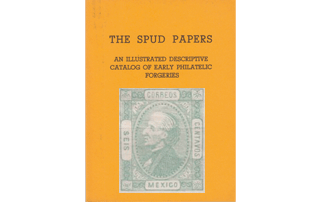Spud Papers – Mexico




 Issue of 1872.
Issue of 1872.
The specimen which is annexed is a very fair sample of the series, all the specimens of which are sold by the Hull firms on their sheets.
The five values are:
- Seis (6) centavos, dull green
- Doce (12) centavos, blue
- Veinticinco (25) centavos, red
- Cincueuta (50) centavos, yellow
- Cien (100) centavos, lilac
In the genuine stamps we find a distinct die for each value, and the paper bearing a blue lithographic pattern at back; the engraving is execrable, so bad that there can really be nothing to prevent their forgery, and use for postage, save the cumbrous system of surcharging each batch of stamps sent to each province with the name of the province, the date, and a number, arbitrary for each name. The word CENTAVOS occurs on the right hand side in the 6c., but on the left in all the others, and the backgrounds vary in fineness in the several values; whereas the forgeries, being from one die, have the background of one uniform coarseness; but the 6c. forgery has the word SEIS on the correct side. Where the originals are so poor, and the forgeries rather excel in boldness of execution, it is somewhat difficult to fix on any particular point, so we will select the left hand frame first, and dissect it sufficiently to enable any one to tell a genuine from this forgery. Above the label are four small curls on each of the imitations, but only three in the genuine. The same label, whether containing SEIS or CENTAVOS, is cut square and straight at the top end in each forgery, but is plainly rounded in all genuine. The forgery delights in a peculiarly square letter o in CENTAVOS, a form which does not occur in the same word in any genuine one. Another, and more crucial test, is that the forgery shews but one outer line, which is border, frame, and all; but in the genuine this outer line is certainly a second, or finishing one, but put so close to the design that it runs into the edges of the labels and corners, which are consequently thickened on the outer parts; whereas the forgery shews a line of uniform thickness everywhere. It is hardly necessary to go any further into details after this last item, but we feel as if we should like to say something about the exasperating expression given to the face on the forgery. The original is not very sweet to look upon, but really it is hardly so wooden-headed as the annexed sample of Hull wares would have us believe. The blue moire pattern lithographed at the backs of the sheets is very closely imitated by the forgeries under discussion, but it is too bold and too blue; the absence of perforation also characterizes these “bogus” stamps.
From “The Spud Papers” by Atless, Pemberton & Earée, 1871-1881.












Leave a Reply
Want to join the discussion?Feel free to contribute!